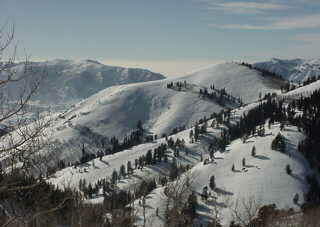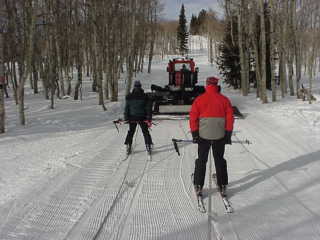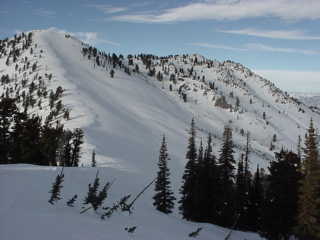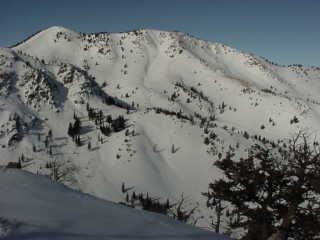and Eric Krupka
(November 2001) – The strange dichotomy that is Powder
Mountain was perhaps best illustrated the day following our departure from
this huge and relatively unknown resort. Hanging around The Red Pine Lodge
at The Canyons, we spoke glowingly of “Pow Mow’s” merits to a cute yuppie
couple sipping on lattés beside the deck. “It’s so cool there,” intoned son
Jonathon, 11. “You ski off the backside of the resort down to the highway
and a blue bus comes by to pick you up.”
n
Muffy wrinkled her nose and nervously smoothed the wrinkles
from her black stretch pants. “Oh my God,” she plaintively murmured. “I only
ride high-speed lifts now.” Her equally perplexed husband moved protectively
to shield her from further exposure to the apparent riffraff.
And that’s plenty fine with us. All the more powder to be preserved
for real skiers and real boarders in the know. Friends, this place is the
veritable embodiment of cool.
LOOKS CAN BE DECEIVING
Perusing an old trail map in a brochure for Powder Mountain,
we noted that the lift-served area looks relatively small. It is thankfully
free, however, from brutal grooming and associated overdevelopment. We also
noted that the trail map indicated an area reserved for snowcat skiing. We
remarked to each other that it looked interesting enough to keep us busy for
a day, or maybe two.
Focus on Utah skiing and riding has recently expanded northward
to encompass Ogden, an hour north of Salt Lake City, thanks to the money poured
into Snowbasin in preparation for the 2002 Olympics. We cast our gaze still
further north, for Powder Mountain lies beyond Snowbasin, through the gorgeous
Ogden Canyon 55 miles north of Salt Lake City. The road through the Canyon
is plenty twisty and scenic, but unlike the roads into the Cottonwood Canyons,
it is rarely closed in bad weather.
The Ogden Valley greets visitors with miles and miles of rolling
ranch land and highest concentration of 4x4s and horses you’ll see in some
time. Powder Mountain overlooks the extreme northeast end of the Valley.
We embarked from our hotel in the idyllic hamlet of Eden, located hard by
the north side of the Pineview Reservoir at the top of Ogden Canyon, noting
that the snow pack was thinning rapidly in the warm March sun.
On the far side of Eden, we began to worry that we had missed
a turn, as we seemed to be passing through a residential area. We however
continued climbing, slowly at first, then the road gradually steepened and
the mountains drew closer to each shoulder. Rounding bend #437, we began to
notice ski tracks dropping off the ridges through the trees on both sides
of the road. The sheer quantum of apparent backcountry further piqued our
interest. Still climbing, we eventually ground into a small parking lot with
one chairlift traveling up the western ridge. After a brief tour of the parking
lot, we decided to continue on in the hope that the main lodge was still to
come.
After a few more twists we hit the end of the road and – as
suspected – the main lodge. A quick altimeter check indicated a heady 8,000
or so feet. Powder Mountain is, for the most part, an “upside down” mountain
in that much of the resort is actually located below the main lodge. In fact,
if you really want to, you can drive even further up the road to the parking
lot of Hidden Lake Lodge, the resort’s highest structure.
Believe it or not, Powder Mountain is America’s largest contiguous
ski resort, spanning an almost overwhelming 5,500 acres of private land owned
by the Cobabe family since the resort’s inception. Patriarch Dr. Alvin Cobabe
decided in the late 1950s that skiing might be somewhat more profitable than
sheep ranching. He had at his disposal a magnificent series of curving northeast-southwest
trending ridges separated by several lightly gladed canyons, the highest of
which top out at nearly 9,500 feet. Most importantly, he had the best snow
in Utah, Alta notwithstanding. While 500 inches falls at each resort on average
annually, it seldom lies untracked in Little Cottonwood ten days after the
latest storm. Here, it really does.
ORIENTATION BY A BUNCH OF BANANAS
Perhaps the best way to describe the layout of Powder Mountain
– and folks, this is a spectacularly insufficient description – is to picture
a bunch of bananas thrown on a table stem side down, with the stem pointing
south to the Hidden Lake Lodge. The bananas themselves form the ridges, and
the intervening valleys are represented by the spaces between the bananas.
Below Hidden Lake Lodge lies the main Powder Mountain Lodge. However, if
you wish to reach the former from the latter, you must first ski down to and
ride up the Timberline Triple, or as we said, drive. We choose the lift on
the advice of a friendly employee who suggested that we use the opportunity
to get a look around. His advice that “You can see the whole resort from
the top of the lift" proved to be the wildest overstatement of the week
– it’s that vast.
A decently groomed trail greeted us at the unloading platform.
Stopping at the top to get our bearings, Powder Mountain was heart-stopping
in its expansiveness. Directly north along the high ridgeline, we could make
out the top of the Paradise lift, the resort’s newest chair. A fixed-grip
quad, Paradise accesses acre upon acre of blue and black trails, glades, and
open faces along both sides of the ridge. This is the “in-bounds” advanced/expert
section of Powder Mountain. Here you’ll also find the longest true lift-served
runs on the mountain – 1,600 vertical feet of sustained drop. The Timberline
Lift itself tops out somewhat above the Paradise lift, with trails almost
connecting to it via the ridgeline, but due to a topographical dip you can’t
ski directly from the top of Timberline to the top of Paradise.
To skier’s right of the Timberline Lift lies another east-trending
line, Sunrise Ridge, served by the Hidden Lake chair – perhaps the world’s
slowest operational double still in existence. About 1,300 vertical feet
of mainly blue-rated runs spill northward off of the entire length of the
ridge. The mellow terrain is markedly sweetened by a profusion of wide-open
aspen and evergreen glades. Much of this portion of the mountain consists
of short, often somewhat steepish pitches, followed by fairly long and undulating
flatter sections. While you can link together a few steep sections in one
run, none are sustained. You’ll in the process discover about 500 acres of
absolutely primo family and intermediate terrain.
At the eastern terminus of Sunrise Ridge, a short poma lift
transports skiers to the ridge’s summit. From there, seemingly endless opportunities
abound. If one chooses to drop off to the extreme skier’s right of the ridge,
you reach the quasi-backcountry terrain of Cobabe Canyon, where black diamond
options spill off both the east- and west-facing sides. The entire Sunrise
Ridge area and Cobabe Canyon dump out at the base of the Paradise Lift after
a short runout.
Alternatively, one can drop north off the backside of the Hidden
Lake Lodge into the vast expanse known as "Powder Country,” containing
some of the resort’s signature terrain and its best secret stashes. These
are known as the “bus runs.” From the top terminals of any of the Hidden Lake,
Timberline, or Sundown chairs, one can ski black diamond-rated glades and
chutes of nearly 2,000 vertical feet all the way back down to the access road.
Once there, a shuttle bus cycles back and forth transporting emerging skiers
and boarders back to the main lodge. Virtually limitless untracked lines
exist in the nearly 800 acres of terrain here. And, the price is right –
it’s included in your lift ticket!
For still another alternative, one can fork over six bucks,
and a snowcat (or snowmobile) will tow you up Lightning Ridge, another largely
expert area to the north of Paradise Ridge. From there, hundreds of additional
options abound down each side of the canyon walls, most of them allowing for
about 2,000 vertical feet of untracked powder. Once again, these runs exit
back to the base of the Paradise lift.
Continuing onward and upward, one can bootpack it north from
Lightning Ridge a further 400 or so vertical feet up to James Peak, the geographical
high point of the resort. James Peak offers a further 600 or so acres of
legitimate double-black chutes and steeps, again funneling directly back to
the base of the Paradise quad.
Finally, you can retain the modestly priced services of a Powder
Mountain guide and ski west off the backside of Lightning Ridge into the Wolf
Canyon area. This is the most extreme terrain accessible from the resort
proper, offering up true adventure skiing for those so inclined. A guide
is required, at least officially, as are avalanche transceivers, shovels and
probes. Be forewarned, however, that the avalanche danger out there is real.
Wolf Canyon offers the longest continuous vertical at the resort, offering
up nearly 4,000 vertical feet of astounding views and technical skiing. The
runs dump out into a very long but scenic runout existing far, far down the
access road beyond the bus pickup points. In short, absent the desire for
a long hike to the lower terminus of the bus runs, transportation back to
the lifts is your own responsibility.
If all of this isn’t enough, you can even arrange to charter
a heliskiing trip from the base lodge. Powder Mountain has partnered with
Diamond Peaks Heliskiing, with the birds lifting off from a pad in reasonable
proximity to the Hidden Lake Ridge.
That’s a lot of options, but they’ve got a lot of area to ski.
As I said, it’s 5,500 acres, with 2,800 of it lift-served, 800 more in Powder
Country, 800 on Lightning Ridge, and the remaining balance comprising Wolf
and Cobabe Canyons.
SO MUCH SNOW, SO LITTLE TIME
The day of our arrival was the latest in a string of sunny and
warm ones, so we puttered around for a while on the groomers, waiting for
the sun to soften up the snow while we attempted to get our bearings. We couldn’t
help but notice the acres upon acres of skiable aspens and evergreens. We
also saw a few Alta-style rock outcrops, most of them obvious from above as
well. In other words, there are no worries about heading through the trees
and suddenly finding yourself hurtling into thin air.
As soon as conditions made it reasonable to do so, we left the
groomers and hit the sunniest open faces we could find. In particular, Paradise
face looked good but, unfortunately, proved to be already a bit sloppy in
some spots, while still hard and crusty in others. Suitably chagrined, we
next sought more shaded areas of the resort in the fervent hope that the absence
of traffic would have allowed softness to linger, despite the passage of time
since the last significant snowfall.
After a ride up the almost absurdly slow Hidden Lake Chair (which
for some unforeseen reason also stopped ridiculously often), we found a few
pockets of loose snow, but the mildly steep pitch ended quickly. While none
of us are detachable lift junkies, the unanimous consensus was, frankly, relief
that Powder Mountain has plans to replace the Hidden Lake chair with a fixed-grip
quad for the 2002-2003 season.
A subsequent run along the Paradise ridgeline delivered a few
pockets of softer snow, some interesting rock outcrops, and more death glop.
We sank boot-deep into sunbaked snow, proving that limited traffic or not,
weather conditions remain paramount to snow quality. Admittedly, the paucity
of snowfall would have rendered conditions at the Cottonwoods or Park City
area resorts virtually unskiable.
We broke for lunch at the Hidden Lake Lodge. As our food cooked
to order, we watched people sunbathing and grilling in the parking lot and
admired the panoramic 360-degree views. Southwest across the Ogden Valley
we could see Snowbasin and Nordic Valley, the latter appearing absurdly tiny
despite its not-insignificant 1,000 feet of vertical. The bill for lunch
proved to be on the low side of average for a ski area, while quality was
on the high side. Most important, another friendly employee served it with
a smile. It was another example of a trend that was to develop throughout
our visit.
|
Some of the “bus run” terrain at Pow Mow. (photo |
After lunch we dropped into the chutes and glades on skier’s
left of Paradise, and at last found a cache of soft, dry snow. With a little
bit of exploration we even found a few turns of untracked snow left over from
the last dump. There are an infinite number of different lines in this area,
but we only skied two of the obvious chutes. So much snow, so little time.
WHERE IS EVERYBODY?!
Following a moderate cold front that rolled through the area
on Friday night, we left town Saturday in a light drizzle, wondering where
the snow line would lie. The previous drizzle had turned to snow at roughly
the 7,000-foot mark. Today, about midway up the access road, fresh flakes
magically appeared. As we pulled into the parking lot, about eight inches
of fresh cover greeted us – and hardly anyone else.
Ok, so maybe eight inches of snow isn’t much
in Utah, but to Eastern ice rats like us, four inches counts as a powder day.
So where was everyone, especially on a Saturday with a week gone by since
the last snowfall? It was only later that we discovered the real secret about
Pow Mow – even powder days don’t generate a crowd. Plus, with the usual 300
to 400 people on a mountain which has 5,500 acres of terrain, that’s about
ten acres per person. We fully intended to track up more than our fair share.
What a change from the previous day! Although whiteout snow
conditions didn’t help at first with our orientation, that meager eight inches
combined with well-placed blow-in on the leeward side of the ridges to generate
a true deep-powder experience. It didn’t hurt that we barely crossed another
track during the following six hours, either.
We spent most of the morning on relatively sane terrain, despite
the beckoning call from acres of steeps. All of the aspen and evergreen glades
off the Hidden Lake chair had become eminently skiable – no underbrush, no
fallen logs, just line after line of fresh snow. All of the trees were sublime,
possessing that perfect pitch that allows your skis to just run. Spacing
between trees was tight enough to give that feeling of isolation, but open
enough to provide plenty of options.
|
“Cat skiing” northern Utah-style does not always
James Peak, some of Powder Mt.’s cat-ski terrain
… Lightning Ridge. (photo Marc Guido)
|
The wide-open faces of Paradise had experienced the same overnight
transformation. The wind had deposited snowdrifts along the top of the ridgeline
and scoured some of the snow off of the face, but we scored some great turns
before heading into the trees about halfway down. A veritable bonanza of trackless
powder, followed by a short section of wide open trees that quickly gave way
to some more open space – and no one there.
At lunch in the main lodge, we dined with Marketing Director
Marc Paulsen, who proved to be a veritable fountain of local knowledge. He
explained that the Cobabe family has long held to a very conservative policy
of financing all resort upgrades and expansion solely through ski area profits
and sales of real estate. If you’ve ever been interested in buying a place
in ski country without going into hock for life, you owe it to yourself to
check this place out. As Marc pointed out a large lodge home under construction
on the opposing ridge, we did a quick mental calculation and were shocked
to discover that the home cost about 1/5 of the price of an equivalent property
in Vail.
Although lunch was not cooked to order today, it was nonetheless
hot, tasty, and again, relatively cheap. The uniformly friendly staff introduced
us to Utah "fry sauce,” a pink concoction of ketchup, mayo, and secret
ingredients designated for french fries, leaving us to wonder what Utahans
would make of poutine back in Québec.
We were introduced after lunch to the affable Jerry, who would
function as our tour guide for the afternoon. The snow and its accompanying
whiteout conditions had by now subsided, allowing the Lightning Ridge cat
skiing area to open. Interestingly, the "cats" turned out to be
high-performance snowmobiles equipped with tow ropes, manned by manically
grinning lifties. These guys rocket up the short ridge with one skier on
board and two on the rope, insurance liability be damned. The resort sells
a book of five rides (an afternoon’s worth) for $30. Add that to a full or
half day ticket for as little as $30, and you have yourself a combination
cat/lift day for about $60 – an unreal price in this day and age for continuous
2,000-vertical-foot laps of steep, untracked terrain!
Even though the “cats” had operated for most of the morning,
fresh snow was in abundance within a one hundred-foot traverse from the drop-off
point. Jerry skidded to a stop above the first series of chutes and offered
us a choice of descents. Realizing that there were eight of us, Eric traversed
another twenty feet to the second chute, yelling back that the first one was
better. Out of the corner my eye, I observed Jerry and Eric jump into the
second chute, which admittedly did hold better snow. There really are no
friends on a powder day.
Jerry next took us over into "Powder Country" to do
a bus run. These west-facing slopes were by now heating up a bit and starting
to stick in the afternoon sun. The pitch, the terrain and the trees, however,
remained almost perfect. Filing onto the funky blue bus at the bottom of
a 2,000-vertical-foot private stash for the ride back to the resort proper
is a positively cool in-bounds experience. I feel sorry for the pants-in-the-boot
tourists back at The Canyons.
4,000 FEET OF BACKCOUNTRY BLISS
by bluebird skies. This day, though, we could feel the previous day’s crust
under the fresh cover on the southern exposures. After meeting Barbara, our
new mountain host, Paulsen tantalizingly intoned that we were to sample Wolf
Canyon after lunch. Suffice it to say that the morning passed relatively
slowly.
After lunch we met up with four Powder Mountain patrollers and
Michael, who for 20 years has acted as the resort’s coolly demented ski school
director. Wolf Canyon offers the steepest, longest descents at Pow Mow, legitimately
deserving of their double diamond rating. Located a short five-minute hike
west of the Sundown lift, the tour traverses some avalanche prone terrain
en route to the real goods, necessitating either the services of a guide or
a good knowledge of backcountry technique and equipment. We eventually exited
on a cornice-capped sub-peak overlooking about 5,000 acres of canyon, vaguely
reminiscent of something out that based Jeep advertisement filmed in the Tetons.
The first thousand or so vertical feet entailed some tricky turns through
the funky crust, but we eventually reached the refuge of some steep evergreens.
Most of these virtually limitless lines culminate with a very picturesque
two-mile runout along the canyon’s edge down to the access road. Michael
advised that moose are often found standing along this runout.
The total Wolf Canyon journey encompasses about 4,000 vertical
feet, eight miles, and 1½ hours. One of our guides, a s&^%-eating grin
plastered across his face, spoke glowingly later that "Alta has the terrain,
but Powder Mountain has the snow." Frankly, sitting on the blue bus
with our group of newfound friends, I had to wholeheartedly agree.
What, ultimately, does Powder Mountain offer that the bigger,
better-known destination resorts in Utah don’t? Well, unless you’re a testosterone-overdosed
hotshot who throws himself off cliffs for fun, you won’t find a bigger, better,
cheaper, friendlier, more charming ski area anywhere. If it were anywhere
else, we’d be admonishing everyone to get there while it’s still good. In
this case, we guarantee that it’ll be good for a long time to come.




